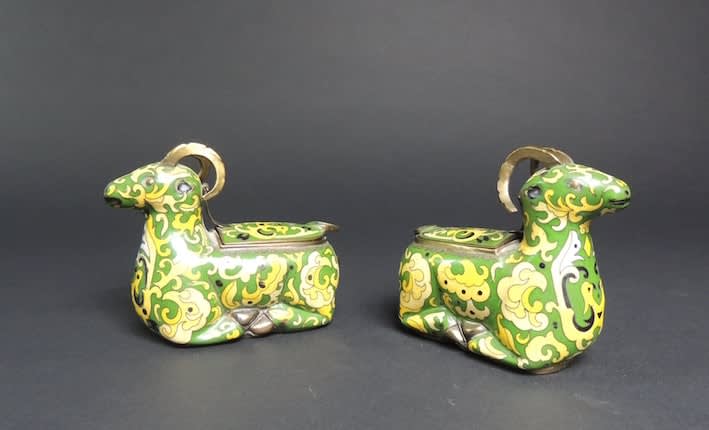Pair of cloisonné ram figurines, 1850 CE - 1900 CE
Bronze
4 x 4.2
CB.166
Each of the rams has been modelled with the four gilt bronze legs tucked underneath the body, the enamels consisting of stylised vegetal elements in a vivid ochre and yellow...
Each of the rams has been modelled with the four gilt bronze legs tucked underneath the body, the enamels consisting of stylised vegetal elements in a vivid ochre and yellow colour against an intense green background.
Each head in a raised alert posture is turned slightly to one side and is surmounted by gilt horns. There is an oval lidded opening on the back of each of the figurines.
Enamelling is a meticulous and extremely time-consuming craft. Enamels are a form of glass coloured with metallic oxides and applied as a paste, usually to a metallic body, generally of copper, although other metals may be also used.
When the object is fired in a kiln to an appropriate temperature, the enamels melt and fuse to the body. The object is then cooled and its surface is polished to a high-gloss finish. There are various enamelling techniques. The simplest is champlevé, where a pattern or design is carved out of a metallic body, with the enamel paste then applied into the resulting hollow, the piece being in consequence fired and finally polished. In cloisonné enamelling, fine wires are used to delineate the areas destined for decoration (cloisons in French, hence cloisonné) into which the enamel paste is then applied before the object is fired and finally polished. These fine wires serve a dual function: they can be an integral part of the decoration while at the same time preventing the molten enamels from flowing into adjoining areas during firing.
Each head in a raised alert posture is turned slightly to one side and is surmounted by gilt horns. There is an oval lidded opening on the back of each of the figurines.
Enamelling is a meticulous and extremely time-consuming craft. Enamels are a form of glass coloured with metallic oxides and applied as a paste, usually to a metallic body, generally of copper, although other metals may be also used.
When the object is fired in a kiln to an appropriate temperature, the enamels melt and fuse to the body. The object is then cooled and its surface is polished to a high-gloss finish. There are various enamelling techniques. The simplest is champlevé, where a pattern or design is carved out of a metallic body, with the enamel paste then applied into the resulting hollow, the piece being in consequence fired and finally polished. In cloisonné enamelling, fine wires are used to delineate the areas destined for decoration (cloisons in French, hence cloisonné) into which the enamel paste is then applied before the object is fired and finally polished. These fine wires serve a dual function: they can be an integral part of the decoration while at the same time preventing the molten enamels from flowing into adjoining areas during firing.
